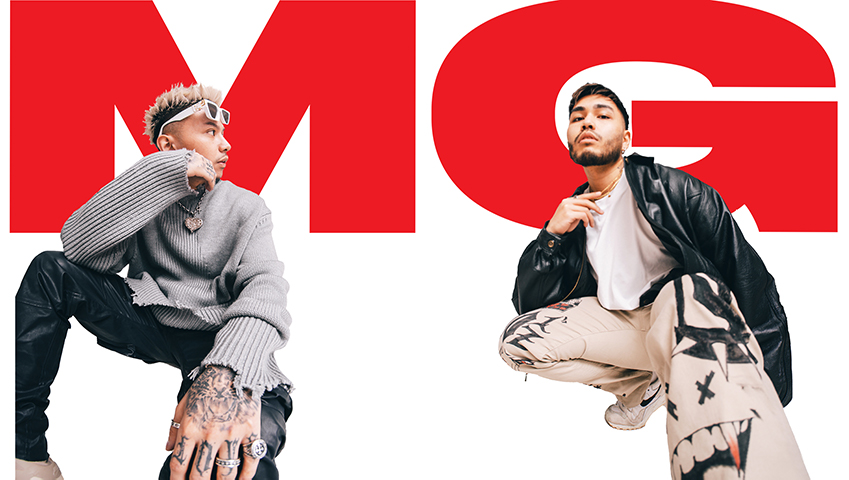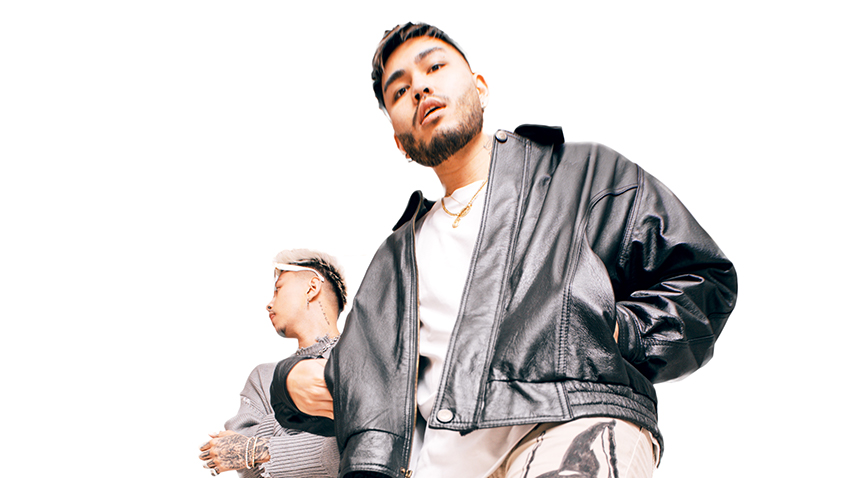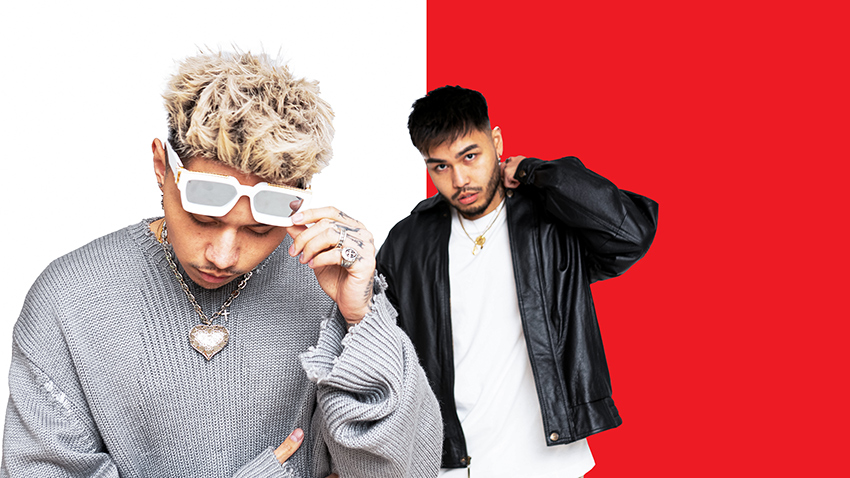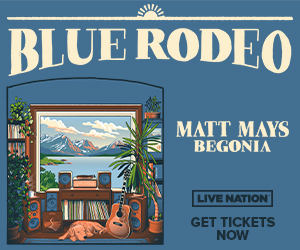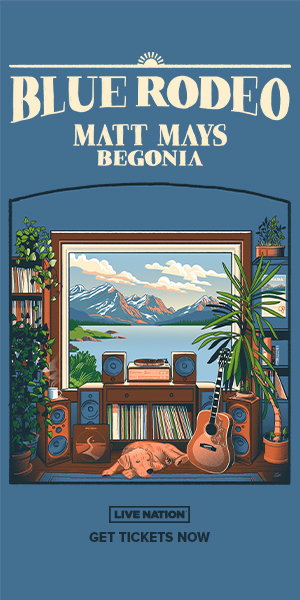Manila Grey
Vancouver hip-hop duo work their asses off to become the musical role models they never had.
Ghostride Neeko And Blame Soliven of Manila Grey have a litmus test for a good song. If they hit play while driving down Knight Street—a long stretch of highway known for fast cars and drag racing that connects Vancouver and their hometown of Richmond— and the song flows with the racing speed and whipping wind, it passes.
“We’ve always had this kind of night rider, late-night drive kind of vibe to our brand,” says Soliven, who goes by Sol. “That’s the final test for a song. You gotta play it down Knight and just kind of vibe to it.”
It’s fitting, then, that the sleek hip-hop duo’s newest album is titled No Saints on Knight Street. Neeko’s ferocious verses throb with 808s that send vibrations through mosh pits or shake the frame of a souped-up Honda Civic, while ice-cold hi-hats cut through the big-room sound as Sol slinks in with his silky falsetto hooks.
“They know that we’re one of the first Filipino acts to break out or even have a JUNO nomination. They know the importance of that.”
Their glistening West Coast sonics recently earned them a JUNO nomination for Breakthrough Group of the Year. Neeko remembers rubbing sleep from his eyes after a late-night recording session as he heard the news: “I woke up to a text from Sol and I was like, ‘Is this a dream? What’s going on here?’”
Sol chimes in, laughing, “When we finally woke up, we were like ‘holy shit, it’s a JUNO.’ I called my mom right away.”
Both Neeko and Sol (not their birth names) are first-generation Canadians, their parents having emigrated to B.C. from the Philippines. Of living in Richmond, Sol explains, “it’s very immigrant-heavy. People are just trying to survive. That’s something Neeks and I could always relate to.”
Separated from Vancouver by the Fraser River, Neeko and Sol grew up with the buzz of the big city just out of reach. Now, as professional artists, they’re gratuitous with the material exhibitionism in their music—cars, sex and money make up the main lyrical content, representative of the fortune they didn’t have as kids. That’s not to say they don’t give a nod to their upbringing: confessional track Long Game (Neeko’s Redemption) is just one of several instances where they do. Long Game feels like an ode to their tough roots and a love note to their strong Filipina moms: rapping about being hungry in food bank lineups, Neeko weightily declares, “Momma, we survived the coldest winters.”
The duo met when they were 13 years old, collecting a tight-knit crew of boys who shared their appreciation for hip-hop music and contemporary street art along the way. Together they formed a group they called the 1z Collective (as in “day ones”). For fans of late-2000s TV series Entourage, aka Sex and the City for men, the narrative of a few rowdy young dudes orbiting the nucleus of their superstar friend will sound familiar.
But the 1z Collective is different: it’s not just a title Sol and Neeko slapped onto their friend group to pat themselves on the back and glorify the odd creative exploit, as collectives can be. When it comes to 1z’s role in Manila Grey, each member brings his own professional skillset to the table and plays a different role: creative director, videographer, producer and touring DJ. They’re more like Odd Future, an alt hip-hop collective responsible for the likes of Tyler the Creator and Frank Ocean.
“All of our friends became professionals. Everyone just kind of managed to make their passions their career. A lot of people think we’re paying some crazy companies to make crazy videos, but honestly it’s just gang, from day one,” Sol asserts. It’s just one of many instances in this interview in which he and Neeko make sure to give their crew love.
The fact that they met the best friends they now call creative partners in grade school keeps them grounded. Manila Grey may seem like a duo, but they don’t talk about themselves in one breath without giving credit to the 1z in the next. The 1z Collective is almost entirely Filipino, although a couple of members represent Pakistan and Iceland.
“It’s this Richmond multiculturalism—the 1z know the weight that it holds. They know that we’re one of the first Filipino acts to break out or even have a JUNO nomination. They know the importance of that. They know they’re a part of that.”
With their first nomination under their belts, and after a sold-out 2019 tour across Canada and Asia routinely filled clubs with upwards of a thousand fans, Manila Grey have come a long way from where they started. And where was that, exactly? Why, nowhere other than at the ultimate expression of the North American dream.
“I was at the mall, doing stupid-ass shit,” laughs Neeko.
“We just spent our high school days making music, especially in the summertime. Every day it was record, do stupid shit, and then record and do stupid shit. So, it was a cycle,” Sol grins mischievously.
They’d cut class and meet at community centres outfitted with microphones, record when their parents weren’t home and run around town tagging walls like any good young Basquiat would do. Naysayers might call them problem kids, but they were obviously committed to their craft early on. Neeko cites visual artist Daniel Arsham and the late street artist Keith Haring as influences, adding that Manila Grey is “a balance of bougie art and hip hop.”
“That’s the true essence of hip hop. Where you originate from, your roots—everybody has some sort of struggle that they compartmentalize. And it’s hard to express. Young Asians should be able to tell that story.”
Now, on their way up, they like to stay connected with their fans, many of whom are just like the young mallrats they once were. One way the duo makes that connection is by watching fan vlogs.
“Post-show, Neeko and I would watch fan vlogs on YouTube,” says Sol. He recounts a vlog recorded at their Manila show: “One kid went there by himself; he’s never been to the big city. He’s vlogging, saying things M A N I L A G R E Y like, ‘Oh, I’ve got their tweet here: looks like they just landed.’ This guy is up at like 9 am, saying goodbye to his mom. He has his Neeko haircut, he has his ‘fit, thinking, ‘I’m going to meet some shorties there.’ To us, that is so fulfilling.”
Neeko sees it as a full circle moment: “It’s funny, because I feel like the fans don’t know that we watch them, but we watch every single one. Sometimes you go on a deep dive, and see what people are posting about Manila Grey. It’s amazing. These kids are just hype. Sol and I would wait at Foot Locker from 12 midnight until eight in the morning so we could get a pair of sneakers. That’s the same experience these kids are going through—just to watch us play a show.”
The guys talk about their younger fans so affectionately that it almost feels as if they’re talking about a younger sibling they feel protective about. Throughout the interview, their demeanor is warm and good-natured: laughing readily, asking me questions in return, beaming when they talk about their moms, tossing around words like “blessed” and phrases like “the come up was real.” I was surprised—it came in such stark contrast to the cool, polished exterior of their brand. They might even be two of the most polite rappers in the game: they logged onto our Zoom call early.
So, what was their come up like, anyway? Success didn’t just pop up overnight for Manila Grey. In fact, their first attempt to launch the duo failed. As Sol recounts, “Neeks and I quit our jobs and the music didn’t work out.”
Their very first song release, 2016’s 1z, sat at a few thousand plays online for the first two months. Both guys feared they made the wrong decision by quitting their jobs in a seedy Richmond casino.
“Neeks was a dealer and I was a security guy. It was very, very dark times. River Rock Casino is not the best place to be at. We wanted to get out of there as soon as possible,” Sol says.
Thinking the music would take off, they both quit their jobs on the same day.
They initially went to LA to chase the dream; it failed. Manila Grey wasn’t created for another three years after that.
“The repercussions of that were bad. We had to really figure it out. I think that’s what put us in the do-or-die mindset, like yo, we either make Manila Grey now, or we don’t. It was just a choice,” says Sol matter-of-factly.
Noses to the grindstone, they cut hair in a barber shop and worked another security gig just so they could put in time on Manila Grey in the midnight hours.
Neeko cites a dogged work ethic and commitment to the music for finally giving Manila Grey its wings.
“Music is not a cheap career to start up. You’ve got to invest in your craft. People say they can’t do it, that it costs too much. And it’s like, no bro, there are 24 hours in a day. If you really want to go get it, go work the eight-hour job, go work the four-hour part time, go put in eight hours in the studio, go sleep for four hours and do it again. Take out all excuses. If you want it, you gotta go for it.”
There were no industry connections, no silver spoon to feed them. As the children of immigrants, Sol and Neeko made sure they worked harder than the rest to make their dream a reality. As clichéd as it may sound—you’ve got to respect their hustle.
Sharing details about the part of the Philippines his family emigrated from, Sol says, “When you go to my home city, there’s a goat and you can get stabbed.”
Neeko adds, “You see the slums, the hardship, the markets and it’s so different. It’s not like Superstore, it’s not like Walmart—markets are just on the street. They’re up at six in the morning, grinding. That’s the part of the Philippines that I knew.”
This struggle is part of the reason both artists gravitated towards hip hop.
“That’s the true essence of hip hop,” says Sol. “Where you originate from, your roots—everybody has some sort of struggle that they compartmentalize. And it’s hard to express. Young Asians should be able to tell that story.”
The other major reason they pursued hip hop is the lack of Asian representation in the genre. Passion mounting in his voice, Neeko explains: “It was definitely hard growing up, because you want to see somebody that looks like you so you can look up to them.”
The term “role model” doesn’t exactly conjure up images of rappers drag racing, waxing poetic about their girl’s insane ass or fanning fat stacks of green Queen Lizzies into a sweaty crowd. But that doesn’t make them bad influences. Sure, they embody the strutting, conspicuous, look-at-me-ness of mainstream hip-hop culture, but a gritty work ethic got them there in the first place.
The hustle they represent isn’t exactly possible for those who live in a town where there is a goat, where they can get stabbed, where they have to grind from 6 am onward to provide for their family.
As first-generation Canadians, the door to accruing wealth and pursuing their dreams is open much wider for them than it is for their loved ones living in less-fortunate parts of the Philippines. And with so many harmful stereotypes of Asians perpetuated in popular Western media throughout modern history, Manila Grey’s unapologetic, swaggering presence blows those restrictive preconceptions wide open.
“We encourage the youth to see us as an example of what you can achieve if you’re just truly passionate about the music,” Sol states with conviction.
The duo puts a distinctly Asian flair into their discography. In the music video for 1z, they taunt the camera as they bob and weave through the aisles of an Asian convenience store, ending up at a table with what looks like a Crock Pot on top. But instead of being filled with simmering dope, it’s a rice cooker. This is Manila Grey after all—not Migos.
Blue Vegeta, a smooth track off No Saints on Knight Street, their fresh new album, is a reference to a superpower-harnessing character from the globally popular Japanese manga series Dragon Ball Z. Further injecting that Filipino feel, they pepper Spanish phrases throughout their oeuvre—Tagalog, one of the Phillipines’ offical languages, features bits and pieces of Spanish as the island nation was once a colony of Spain.
Another art form they’re passionate about? Fashion.
Sporting everything from utility vests à la Off White to shiny pleather pants, they’re comfortable playing around with their style. Counting obvious streetwear legends Virgil Abloh and Jerry Lorenzo as influences, Neeko also nods to Rhuigi Villaseñor, “another Filipino in the mix that’s killing the fucking game.”
The duo styles themselves for shoots and gigs, with a keen eye for one very specific detail.
“We look at a lot of silhouettes. Like, if you were fully silhouetted, is it dope? I think Kanye is amazing at that,” Sol enthuses.
Perhaps that’s why he sported a North Face puffer at a packed gig in Montreal before COVID. It’s a trend among rappers onstage, albeit a wildly impractical one. When asked how he performs in packed clubs wearing a coat designed for -30°C weather, he laughs: “It looks good in photos, it feels better—you go out there a little more confident. But it’s not the best idea. I took it off after two or three songs.”
Always a team effort, the 1z Collective gives their two cents. “The team will tell you if your outfit is wack. If you’re rocking a fedora and suspenders, they’ll be like, ‘you might need to go back and change.’”
The hype surrounding Manila Grey may be accelerating, but they aren’t at risk of forgetting where they started. Cruising down Knight Street isn’t just about testing the limits of the speedometer—it’s also a place to reminisce, the calm eye of the storm. Sol concludes, “Every time we’re driving down there, that’s when we just talk, like ‘holy shit, how’d this all happen?’ Those are the nights that we cherish.”

